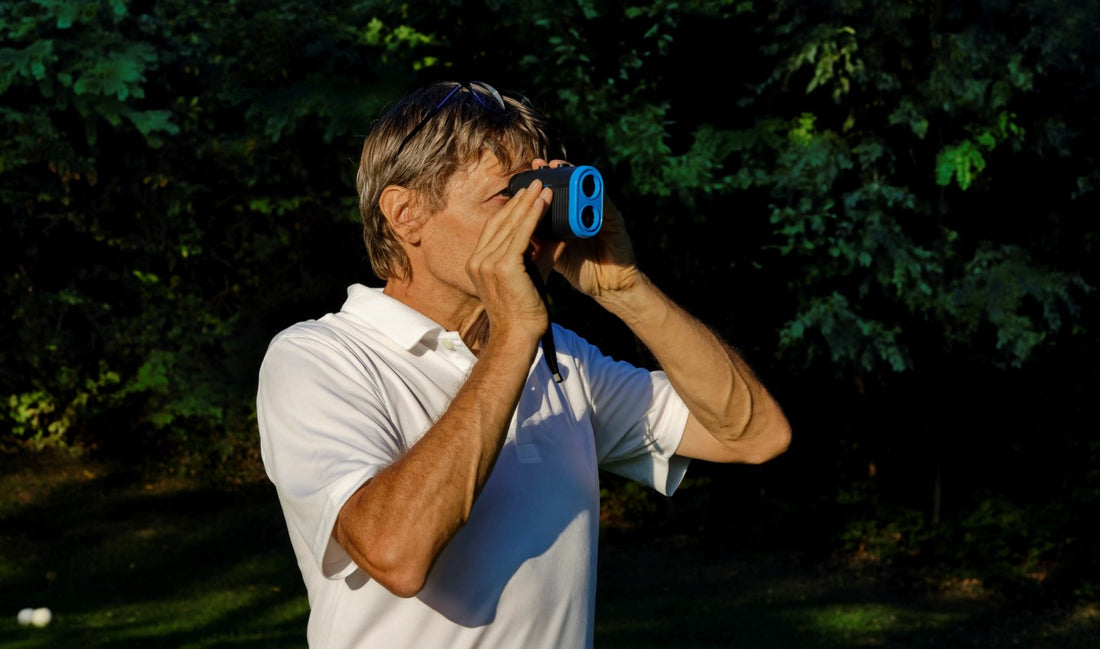How Does a Laser Rangefinder Work

A laser rangefinder, also known as a laser telemeter, is a device that measures distances by using a laser beam in scenarios where other methods cannot. But how does a laser rangefinder do its thing? Let's learn how a laser rangefinder works.
Laser Rangefinder Construction
A normal laser rangefinder consists of four main components:
A laser transmitter: A tiny laser gun inside the rangefinder shoots a laser light toward whatever you're pointing at.
A receiver: The special light catcher waits for that same laser light to bounce back from the target.
A timer: The timer measures the time interval between the emission and detection of the laser pulse.
A processor: The processor inside the rangefinder uses the recorded time and the speed of light to figure out exactly how far away the target is.
Laser Rangefinder Working Principle
Imagine you're playing catch with a friend. You throw the ball, and it takes some time to reach your friend. Now, if you know how fast the ball travels, and you measure the time it took for the ball to reach your friend, you can calculate the distance between you two.
A laser rangefinder works on a similar principle. It sends out a beam of light (the laser) towards the target. This light travels at an incredibly fast speed - the speed of light, which is known. When the laser reaches the object, it bounces back towards the rangefinder. The rangefinder measures the time it took for the light to travel back.
Since we know the speed of light is 300,000 kilometers per second, we can use this time measurement to calculate the distance the light traveled. The formula for calculating the distance is:
Distance = speed of light * time /2
It has to divide the distance bt two because the laser made a round trip. That's how a laser rangefinder works! It's like playing a super-fast, high-tech game of catch with a beam of light.
However, this formula assumes that the speed of light is constant in the medium. In reality, the speed of light can vary depending on factors such as temperature, pressure, humidity, and dust particles in the air. Therefore, some corrections may be needed to account for these variations.
Laser Rangefinder Uses
Laser rangefinders have diverse applications across industries. Some of them are:
- Surveying: Laser rangefinders are used for measuring distances, angles, elevations, and coordinates of land features and structures. They can also be combined with GPS (Global Positioning System) and GIS (Geographic Information System) to create accurate maps and models.
- Hunting: Hunters can use laser rangefinders to measure the distance to the target. They can also integrate rangefinders with ballistic calculators and scopes to improve accuracy and safety.
- Military: Laser rangefinders are used for targeting, reconnaissance, surveillance, and fire control. They can also be mounted on vehicles, aircraft, drones, and weapons to enhance their capabilities and performance.
- Engineering: Laser rangefinders are used for measuring dimensions, shapes, positions, and movements of objects and structures. They can also be used for quality control, inspection, alignment, calibration, and testing.
- Construction and working: A laser rangefinder ensures precise distance measurements which are critical for accurate project planning and execution in construction.
- Golf: Rangefinders help golfers strategize their next swing by giving them the exact yardage. They can also be used for coaching, training, analysis, and improvement in other spots.
How to Use a Laser Rangefinder
As addressed, a laser rangefinder can be used in many cases. Let’s see how to use a laser rangefinder for hunting.
Step 1. Ensure clear visibility to the target. Push the power button.
Step 2. Point the rangefinder at the target.
Step 3. Push the button again to get the distance reading.
That’s it. A laser rangefinder can help you easily measure distances.
Types of Laser Rangefinders
Laser rangefinders can be classified into three main types based on their working mechanisms: pulse, continuous wave, and phase-shift rangefinders.
Time-of-Flight Laser Rangefinders: These are the most common type of laser rangefinder. They work by measuring the time it takes for a laser pulse to travel to the target and back.
Phase-Shift Laser Rangefinders: These use a continuous laser beam and measure the phase shift of the beam to determine the distance to the target.
Interferometric Laser Rangefinders: These are the most accurate type of laser rangefinder, but they are also the most expensive. They use the interference pattern of two laser beams to measure the distance to the target.
Technological Advancements
The first laser rangefinder was developed in the early 1960s. The first commercially available handheld laser rangefinder is the Barr & Stroud LF1 in 1965.Over the years, laser rangefinder technology has advanced significantly. Some of the recent innovations are:
- Miniaturization: Laser rangefinders have become smaller, lighter, and more portable. They can also be integrated with smartphones, cameras, watches, glasses, etc.
- Digitization: Laser rangefinders have become more intelligent, interactive, and connected. They can also display, store, process, and transmit data in various formats and platforms.
- Optimization: Laser rangefinders have become more accurate, reliable, and versatile. For example, ERDI 1535 wavelength laser rangefinder module can also adapt to different environments, conditions, and tasks. It can also compensate for inclination and atmospheric pressure.
These technological advancements have made laser rangefinders more accessible, affordable, and useful for various purposes and users.
Conclusion
That's how Laser rangefinders work to measure the distance to a target. They work based on the time-of-flight, continuous wave, or phase-shift measurement methods. They have diverse applications across industries such as surveying, hunting, military, engineering, and sports.
They have also advanced significantly in terms of miniaturization, digitization, and optimization. Laser rangefinders are an important tool for providing accurate and reliable distance measurements in various situations and tasks.

